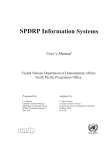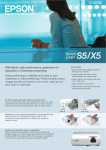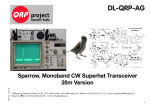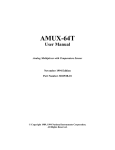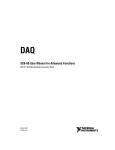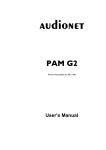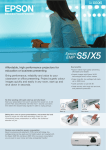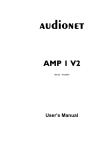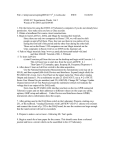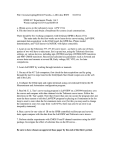Download SCB-68 68-Pin Shielded Connector Block Installation Guide
Transcript
NATIONAL INSTRUMENTS ® The Software is the Instrument ® SCB-68 68-Pin Shielded Connector Block Installation Guide Part Number 320745-01 This guide describes how to connect and use the SCB-68 68-pin shielded connector block with National Instruments 68-pin products. In addition to the SCB-68 kit contents, you need Phillipshead number 1 and number 2 screwdrivers, a 0.125 in. flathead screwdriver, long-nose pliers, wire cutters, and wire insulation strippers. If you are adding components, you also need a soldering iron and solder, and resistors and capacitors (specific to your application). Introduction The SCB-68 is a shielded board with 68 screw terminals for easy connection to National Instruments 68-pin products. When you use the SCB-68 with the AT-MIO-16X or MIO-16E Series boards, you can use the 16 screw terminals for signal connection to the 16 analog inputs. There is a breadboard area for adding resistance-capacitance (RC) filtering, an attenuator, 4 to 20 mA current sensing, and open thermocouple detection. There is also a cold-junction temperature sensor for use with thermocouples. When you are using an unmodified SCB-68 with other 68-pin products, you can configure the five switches to give you a general-purpose 68-screw terminal connector block. The SCB-68 has a strain-relief bar for securing signal wires or cables. What Your Kit Should Contain The SCB-68 68-pin shielded connector block kit (part number 776844-01) contains the following components: Kit Component Part Number SCB-68 68-pin shielded connector block SCB-68 Quick Reference Label SCB-68 68-Pin Shielded Connector Block Installation Guide 182470-01 182509-01 320745-01 If your kit is missing any components, contact National Instruments. Figure 1 shows how to remove the SCB-68 shielded connector block from its box. _____________________________ Product and company names are trademarks or trade names of their respective companies. © 1994 National Instruments Corporation. All rights reserved. January 1994 Figure 2 shows the SCB-68 board parts locator diagram. Figure 2. SCB-68 Board Parts Locator Diagram © National Instruments Corporation 3 SCB-68 Connector Block Installation Guide Switch Settings and Temperature Sensor Configuration To accommodate thermocouples with the AT-MIO-16X and MIO-16E Series boards, the SCB-68 connector block has a temperature sensor for cold-junction compensation. To power the temperature sensor, set switches S1, S2, and S3 as shown in Figures 3, 4, and 5. Notice that this also turns the signal conditioning accessory power on (accessories can include temperature sensors and signal conditioning circuitry). You can configure the temperature sensor as follows: • For single-ended operation, connect referenced single-ended analog channel 0 to the temperature sensor by switching S5 to the up position. The signal is referenced to analog input ground. Set the switches as shown in Figure 3. S1 S2 S5 S4 S3 Figure 3. Single-Ended Switch Configuration • For differential operation, connect differential analog channel 0 to the temperature sensor by switching S5 and S4 to the up position, as shown in Figure 4. S1 S2 S5 S4 S3 Figure 4. Differential Switch Configuration • To disable the temperature sensor, set switches S5 and S4 in the down position, as shown in Figure 5. This is the factory default. S1 S2 S5 S4 S3 Figure 5. Disabled Temperature Sensor Switch Configuration SCB-68 Connector Block Installation Guide 4 © National Instruments Corporation • For use with a 68-pin board, you can bypass all of the circuitry using the switch configuration shown in Figure 6. Notice that when switches S1, S2, and S3 are set as shown in Figure 6, the temperature sensor and accessory power are off. S1 S2 S5 S4 S3 Figure 6. Switch Configuration for General-Purpose Use with a 68-Pin Board Temperature Sensor Output and Accuracy The SCB-68 temperature sensor outputs 10 mV/°C and has an accuracy of ±1° C. You can determine the temperature using the following formulas: T(°C) =100 x V t T(°C) = TK - 273.15 where TK is the temperature in Kelvin and Vt is the temperature sensor output voltage. T(° F) = [T(°C)] 9 + 32 5 where T(°F) and T(°C) are the temperature readings in degrees Fahrenheit and degrees Celsius, respectively. Note: Use the average of a large number of samples to obtain the most accurate reading. Noisy environments require more samples for greater accuracy. Fuse and Power One of the +5 V lines from the DAQ board (pin 8) is protected by an 800 mA fuse. Pin 14 is also +5 V and is not fuse protected on the SCB-68. Shorting pin 14 to ground will blow the MIO fuse, which is usually socketed. If the SBC-68 does not work when you turn the DAQ board on, first check the switch settings, then check both the 800 mA fuse on the SCB-68 board and the output fuse (if any) on the DAQ board. Before replacing any fuses, check for short circuits from power to ground. The 5 V power on the SCB-68 is filtered with a 470 Ω series resistor (R21); as the filtered 5 V is loaded, the voltage decreases. Pad R20 is in parallel with R21 and you can install a resistor if needed. Shorting R20 bypasses the filter while capacitatively coupling DGND and AGND, and is not recommended. © National Instruments Corporation 5 SCB-68 Connector Block Installation Guide Quick Reference Label A quick reference label is in your kit for your convenience. This label shows the switch configurations and defines the screw terminal pinouts for the AT-MIO-16X and MIO-16E Series boards. You can put the label on the inside of the SCB-68 cover for easy reference. Signal Connection The following warnings contain important safety information concerning hazardous voltages and terminal blocks. Warnings: KEEP AWAY FROM LIVE CIRCUITS. Do not remove equipment covers or shields unless you are trained to do so. If signal wires are connected to the module or terminal block, dangerous voltages may exist even when the equipment is turned off. To avoid dangerous electrical shock, do not perform procedures involving cover or shield removal unless you are qualified to do so. Before you remove the cover, disconnect the AC power or any live circuit from the terminal block. The chassis GND terminals on your terminal block are for grounding highimpedance sources such as a floating source (1 mA maximum). Do NOT use these terminals as safety earth grounds. Do not connect high voltages to the SCB-68 even with an attenuator circuit. Never connect voltages ≥42 Vrms. National Instruments is NOT liable for any damages or injuries resulting from improper use or connection. To connect the signal to the terminal block, perform the following steps: 1. Disconnect the 68-pin cable from the SCB-68 if it is connected. 2. Remove the shielding screws on either side of the top cover with a Phillips-head number 1 screwdriver (see Figure 1). You can now open the box. 3. Configure the switches and other options relative to the types of signals you are using as explained in the Switch Settings and Temperature Sensor Configuration section of this guide. 4. Loosen the strain-relief screws with a Phillips-head number 2 screwdriver. Slide the signal wires through the front panel strain-relief opening. You can also remove the top strain-relief bar if you are connecting many signals. Add insulation or padding if necessary. 5. Connect the wires to the screw terminals by stripping off 0.25 in. of the insulation, inserting the wires into the green terminals, and tightening the screws. 6. Reinstall the strain-relief bar (if you removed it) and tighten the strain-relief screws. 7. Close the top cover. 8. Reinsert the shielding screws to ensure proper shielding. You can now connect the terminal block to the 68-pin connector. SCB-68 Connector Block Installation Guide 6 © National Instruments Corporation Removing the SCB-68 Board To solder components in place, you can remove the SCB-68 board using the following steps: 1. Disconnect the 68-pin cable from the SCB-68 if it is connected. 2. Remove the shielding screws on either side of the top cover with a Phillips-head number 1 screwdriver. You can now open the box. 3. Loosen the strain-relief screws with a Phillips-head number 2 screwdriver. 4. Remove the signal wires from screw terminals. 5. Remove the board mount screws and the 68-pin connector screws. 6. Tilt the board up and pull it out. To reinstall the SCB-68 board, reverse the order of the steps. Application Notes When you use the SCB-68 with the AT-MIO-16X or MIO-16E Series boards, you can use the 16 screw terminals for signal connection to the 16 analog inputs. There is a breadboard area for these inputs to allow RC filtering, 4 to 20 mA current sensing, open thermocouple detection, and an attenuator. There are also pads for DAC0OUT, DAC1OUT, and EXTTRIG to permit RC filtering and an attenuator. The open component positions on the SCB-68 board make adding signal conditioning components to the analog input signals easier. Figure 7 shows an example for a specific input channel, and all of the channels are arranged the same way. Soldering and Desoldering on the SCB-68 Board Some applications discussed here require you to make modifications to the printed circuit board, usually in the form of adding components. The SCB-68 board is shipped with wire jumpers in the F and G positions (see Figure 7); you must remove them to use the positions. Use a lowwattage soldering iron (20 to 30 W) when soldering to the board. To desolder on the SCB-68, vacuum-type tools work best. Be careful to avoid damaging the component pads when desoldering. Use only rosin-core electronic grade solder, because acid-core solder damages the printed circuit board and components. ACH0+ +5V R22(A) RC12(B) R4(F) 68 RC4(E) R23(C) 34 R5(G) RC13(D) AIGND ACH8+ or ACH0- Figure 7. Channel Configuration Diagram © National Instruments Corporation 7 SCB-68 Connector Block Installation Guide Channel Configurations You can configure the analog input channels of an MIO-16 board for one of three input modes– differential, referenced single-ended, or nonreferenced single-ended. These modes are called DIFF, RSE, and NRSE input modes, respectively. As described in your MIO-16 user manual, the input configuration of the MIO-16 board depends on the type of signal source you are using. There are two types of signal sources–nonreferenced or floating signals, and ground-referenced signals. To measure floating signal sources, configure the MIO-16 for referenced single-ended input or differential input with bias resistors. To measure ground-referenced signal sources, configure the MIO-16 for nonreferenced single-ended input or differential input. Both types of signal sources and the recommended methods for MIO-16 board connection are discussed as follows. Connecting Nonreferenced or Floating Signal Sources A floating signal source is a signal source that is not connected in any way to the building ground system, but has an isolated ground-reference point. If an instrument or device has an isolated output, that instrument or device falls into the floating signal source category. Some examples of floating signal sources are outputs for thermocouples, transformers, battery-powered devices, optical isolators, and isolation amplifiers. The ground reference of a floating source must be tied to the ground of the DAQ board to establish a local or onboard reference for the signal. Differential Inputs To provide a return path for the instrumentation amplifier bias currents, floating sources must have a 10 to 100 kΩ resistor to AIGND on one input if they are DC-coupled, or on both inputs if sources are AC-coupled. You can install bias resistors in positions B and D (see Figure 7) of the SCB-68. For more detailed information on connections to floating signal sources and differential inputs, refer to the configuration chapter in your MIO-16 board user manual. Single-Ended Inputs When measuring floating signal sources, configure your MIO-16 board to supply a ground reference. Therefore, you should configure the MIO-16 for referenced single-ended input. In this configuration, the negative input of the MIO-16 instrumentation amplifier is tied to the analog ground. Therefore, you should use the SCB-68 board in its factory configuration. In the factory configuration, jumpers are in the two series positions, F and G (see Figure 7). In this configuration, you should tie all of the signal grounds to AIGND. Connecting Ground-Referenced Signal Sources A grounded signal source is connected in some way to the building system ground; therefore, the signal source is already connected to a common ground point with respect to the DAQ board (assuming that the host computer is plugged into the same power system). Nonisolated outputs of instruments and devices that plug into the building power system fall into this category. SCB-68 Connector Block Installation Guide 8 © National Instruments Corporation Differential Inputs If the MIO-16 DAQ board is configured for differential inputs, ground-referenced signal sources connected to the SCB-68 board need no special components. You can leave the inputs of the SCB-68 board in the factory configuration, that is, with the jumpers in the two series positions, F and G (see Figure 7). Single-Ended Inputs When you measure ground-referenced signals, the external signal supplies its own reference ground point, and the MIO-16 should not supply one. Therefore, you should configure the MIO-16 board for nonreferenced single-ended input mode. In this configuration, tie all of the signal grounds to AISENSE, which connects to the negative input of the instrumentation amplifier on the MIO-16 board. You can leave the SCB-68 inputs in the factory configuration, that is, with jumpers in the series position (F or G, depending on the channel). Do not use the open positions that connect the input to AIGND, A and C (see Figure 7), in this configuration. Therefore, you should build signal conditioning circuitry requiring a ground reference in the custom breadboard area using AISENSE as the ground reference instead of building the circuitry in the open component positions. Referencing the signal to AIGND can cause inaccurate measurements resulting from an incorrect ground reference. Building RC Filters You can connect RC filters, which can reduce noise, to the SCB-68 analog inputs. You can build single or differential RC filters using the pads on the SCB-68. Filtering increases settling time to the time constant of the filter you use. Adding RC filters to scanning channels greatly reduces the scanning rate; settling times can be 10 T (T = RC) or longer. Refer to Application Note 043, Measuring Temperature with Thermocouples (National Instruments part number 340524-01) to determine if the settling time will affect your signal measurements. Single-Ended RC Filters You can build single RC filters using the pads F and B for one channel and G and D for the next channel. Solder the resistor in position F or G and the capacitor in position B or D. The following equation shows how to determine your cutoff frequency (Fc ) and settling time depending on the resistors and capacitators you use. Fc = 1/(2 πRC) Differential RC Filters You can build a differential RC filter using the pads F and E. Solder the resistor in position F and the capacitor in position E. The following equation shows how to determine your cutoff frequency (Fc ) and settling time depending on the resistors and capacitators you use. Fc = 1/(2 πRC) © National Instruments Corporation 9 SCB-68 Connector Block Installation Guide Using 4 to 20 mA Inputs You can connect a resistor to the analog inputs at the SCB-68 board for use with current sourcing devices. You can perform single-ended or differential sensing using the SCB-68 pads. Accuracy depends on the resistor you use. Never exceed ±10 V at the analog inputs. Single-Ended Inputs Use position B for one channel and position C for the next channel. Leave the jumpers in place for each channel, position F for one and position G for the next . Differential Inputs Use position E for each channel you are using for current sensing. Leave the jumpers in positions F and G for each channel. Building Attenuators (Voltage Dividers) You can connect attenuators (voltage dividers) to the SCB-68 analog inputs. Attenuators can reduce a signal that is outside the normal input range of the DAQ board (±10 V maximum). Warning: The SCB-68 board is not designed for any input voltages greater than 42 V, even if a user-installed voltage divider reduces the voltage to within the input range of the DAQ board. Input voltages greater than 42 V can damage the SCB-68 board, any and all boards connected to it, and the host computer. Overvoltage can also cause an electric shock hazard for the operator. National Instruments is NOT liable for damage or injury resulting from such misuse. Single-Ended Input Attenuators There is a two-resistor circuit for attenuating voltages at the single-ended inputs on the SCB-68. Install resistors in positions F and B for one channel and G and C for the next channel. You can determine the gain (G) of this attenuator using the following formula: G = Rb/(Rb + Rf) or G = Rg/(Rg + Rc) Therefore, the input to the MIO-16 board (VMIO) is computed as follows: VMIO = VSC * G where VSC is the voltage applied to the SCB-68 screw terminals. The accuracy of this gain equation depends on the tolerances of the resistors you use. Differential Input Attenuators There is a three-resistor circuit for attenuating voltages at the differential inputs on the SCB-68. Use positions E, F, and G for the resistors. SCB-68 Connector Block Installation Guide 10 © National Instruments Corporation Use the following equation to determine the sources of error: G = Re/(Re + Rf + Rg) Therefore, the input to the MIO-16 board (VMIO) is computed as follows: VMIO = VSC * G where VSC is the voltage applied to the SCB-68 screw terminals. The accuracy of this gain equation depends on the tolerances of the resistors you use. Using the SCB-68 Board for Thermocouple Measurements The maximum voltage level thermocouples generate is typically a few millivolts. Therefore, you should use an MIO-16 with high gain for best resolution. You can measure thermocouples in either differential or single-ended configurations. The differential configuration has better noise immunity, but the single-ended configuration has twice as many inputs. The MIO-16 board must have a ground reference because thermocouples are floating signal sources. Therefore, you must use bias resistors if the board is in differential mode. For single-ended configuration, use the referenced single-ended input configuration. Cold-junction compensation with the SCB-68 board is accurate only if the temperature sensor reading is close to the actual temperature of the screw terminals. When you are reading thermocouple measurements, keep the SCB-68 board away from drafts or other temperature gradients such as those caused by heaters, radiators, fans, and very warm equipment. Input Filtering and Open Thermocouple Detection (Optional) To reduce noise, you can connect a lowpass filter. Refer to the Building RC Filters section earlier in this guide. Build open thermocouple detection circuitry by connecting a high-value resistor between the positive input and +5 V. The value of this resistor is relatively unimportant; a few megohms or more works fine. With a high-value resistor, you can detect an open or defective thermocouple. If the thermocouple opens, the voltage measured across the input terminals rises to +5 V, a value much larger than any legitimate thermocouple voltage. The 100 kΩ resistor between the negative input and AIGND is a bias current return path as described in the Connecting Floating Signal Sources section earlier in this guide. Differential Open Thermocouple Detection Use position A to connect a high-value resistor between the positive input and +5 V. Leave the jumpers in place (positions F and G) for each channel used. Single-Ended Open Thermocouple Detection Use position A for one channel and D for the next channel when you connect a high-value resistor between the positive input and +5 V. Leave the jumpers in place for each channel, position F for one channel and G for the next channel. © National Instruments Corporation 11 SCB-68 Connector Block Installation Guide RC Filters and Attenuators for DAC0OUT, DAC1OUT, and EXTTRIG You can connect RC filters and attenuators to the DAC0OUT, DAC1OUT, and EXTTRIG signals at the SCB-68 board. RC filters can reduce noise. You can build these using the SCB-68 pads. Filtering increases settling time to the time constant of the filter you use. RC Filters You can build single RC filters using the pads R1 and RC1 for EXTTRIG, R2 and RC2 for DAC1OUT, and R3 and RC3 for DAC0OUT. Solder the resistor in position R1, R2, or R3, and the capacitor in position RC1, RC2, or RC3. Determine your cutoff frequency and settling time using the following formulas: Fc = 1/(2 πRC) Settling time = 9 T for 12-bit DACs 12 T for 12-bit DACs Attenuators You can connect attenuators (voltage dividers) to the SCB-68 board. Attenuators can reduce a signal that is outside the normal input range of the DAQ board (±10 V maximum). There is a two-resistor circuit for attenuating voltages on the SCB-68 at DAC0OUT, DAC1OUT, and EXTTRIG. Use pads R1 and RC1 for EXTTRIG, R2 and RC2 for DAC1OUT, and R3 and RC3 for DAC0OUT for the resistors. You can determine the gain (G) of this attenuator using the following formula: G = RC1/(RC1 + R1) or G = RC2/(RC2 + R2) or G = RC3/(RC3 + R3) Warning: The SCB-68 board is not designed for any input voltages greater than 42 V, even if a user-installed voltage divider reduces the voltage to within the input range of the DAQ board. Input voltages greater than 42 V can damage the SCB-68 board, any and all boards connected to it, and the host computer. Overvoltage can also cause an electric shock hazard for the operator. National Instruments is NOT liable for damage or injury resulting from such misuse. Sources of Error When making thermocouple measurements with the SCB-68 board and an MIO-16 board, the possible sources of error are compensation, linearization, measurement, and thermocouple wire errors. Compensation error can arise from two sources–inaccuracy of the temperature sensor, and temperature differences between the sensor and the screw terminals. The sensor on the SCB-68 board is specified to be accurate to ±1° C. You can minimize temperature differences between the sensor and the screw terminals by keeping the SCB-68 board away from drafts, heaters, and warm equipment. SCB-68 Connector Block Installation Guide 12 © National Instruments Corporation Thermocouple output voltages are nonlinear with respect to temperature. Conversion of the voltage output to temperature using either look-up tables or polynomial approximations introduces linearization error. The linearization error is dependent on how closely the table or the polynomial approximates the true thermocouple output. For example, you can reduce your linearization error by using a higher degree polynomial. Measurement error is the result of inaccuracies in the plug-in board. These inaccuracies include gain and offset. If the board is properly calibrated, the offset error should be zeroed out. The only remaining error is a gain error of ±0.08% of full range (see the MIO-16 specifications). If the input range is ±10 V and the gain is 500, gain error contributes 0.0008 x 20 mV, or 16 µV of error. If the Seebeck coefficient of a thermocouple is 32 µV/°C, this measurement error adds 0.5° C of uncertainty to the measurement. For best results, you must use a well-calibrated MIO-16 board so that offsets can be ignored. You can eliminate offset error, however, by grounding one channel on the SCB-68 board and measuring the voltage. You can then subtract this value, the offset of the MIO-16, in software from all other readings. Thermocouple wire error is the result of inconsistencies in the thermocouple manufacturing process. These inconsistencies, or nonhomogeneities, are the result of defects or impurities in the thermocouple wire. The errors vary widely depending on the thermocouple type and even the gauge of wire used, but a value of ±2° C is typical. For more information on thermocouple wire errors and more specific data, consult your thermocouple manufacturer. For best results, use the average of many readings (about 100 or so); typical absolute accuracies should then be about ±2° C. Specifications This section lists the SCB-68 specifications. These ratings are typical at 25° C unless otherwise stated. The operating temperature range for this board is 0° to 70° C. Analog Input Number of channels Cold-junction sensor Accuracy Output Other signals Eight differential, 16 single-ended ±1.0° C over a 0° to 110° C range 10 mV/°C All other MIO-16 I/O signals are available at screw terminals Power Requirement Power consumption (at +5 VDC ±5%) Typical Maximum 1 mA with no signal conditioning installed 800 mA from host computer Note: The power specifications pertain to the power supply of the host computer when using internal power or to the external supply connected at the +5 V screw terminal when using external power. The maximum power consumption of the SCB-68 is a function of the signal conditioning components installed and any circuits constructed on the general-purpose breadboard area. If the SCB-68 is being powered from the host computer, the maximum +5 V current draw is fuse-limited to 800 mA. © National Instruments Corporation 13 SCB-68 Connector Block Installation Guide Physical Box dimensions (including box feet) I/O connectors Screw terminals 7.7 by 6.0 by 1.8 in. (19.5 by 15.2 by 4.5 cm ) One 68-pin male SCSI connector 68 Operating Environment Temperature Relative humidity 0° to 70° C 5% to 90% noncondensing Storage Environment Temperature Relative humidity SCB-68 Connector Block Installation Guide -55° to 125° C 5% to 90% noncondensing 14 © National Instruments Corporation
















